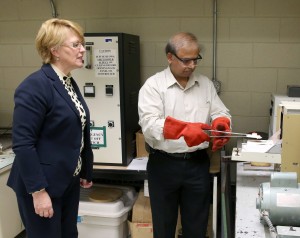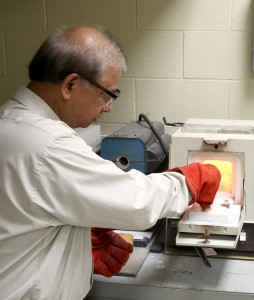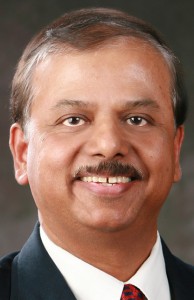
Natalia Sobczak, of Poland, and UW-Stout’s Rajiv Asthana conduct a test on wetting of an oxide ceramic by molten copper in the Ceramic and Powder Metallurgy Lab in Fryklund Hall.
Menomonie, Wis. — It was midwinter in Wisconsin, but blazing heat was the focus of a Polish scholar’s two-week visit to University of Wisconsin-Stout.
Natalia Sobczak, head of the Center for High-Temperature Studies at Foundry Research Institute in Krakow, Poland, was on campus Jan. 9-23 to continue — in person — her collaborative research with a UW-Stout professor and to give a presentation.
While temperatures hovered at about 25 degrees outside, Sobczak and UW-Stout Professor Rajiv Asthana discussed, in the Ceramic and Powder Metallurgy Lab at Fryklund Hall, the interaction of ceramics and metals at temperatures as high as 3,000 degrees.
At such temperatures, many metals are in a liquid state.
In Krakow, Sobczak studies the complex interactions between ceramics and metals by manipulating metal droplets to contact ceramics in a vacuum. In a first-of-its-kind study, Sobczak is researching interaction of molten metals with new types of materials, such as graphene and nanotubes.
In foundries, metal should not be allowed to wet crucibles. Wetting causes crucible degradation and metal contamination. But in joining applications, metal should wet the ceramic to create a strong bond.
“It’s an opportunity to observe the reactions and design new materials. It gives us a lot of useful information of practical importance,” Sobczak said.

UW-Stout’s Rajiv Asthana, who does research for NASA, conducts a test in the Ceramic and Powder Metallurgy Lab at UW-Stout.
“No other laboratory in the world has the instrumentation and technology to study the dynamics of reactive wetting of molten metals at a level of sophistication and detail that Dr. Sobczak has developed in her lab,” Asthana said. “She is conducting ground-breaking research in high-temperature liquid-state materials science that impacts melting technology, casting, joining, composites and other application areas.”
Research on how metals wet ceramics is valuable in the aerospace and automotive industries. Sobczak is doing research with funding from multiple sources, including the European Space Agency. Asthana’s work aids the U.S. space agency, NASA.
“It’s very important research being conducted at only a small number of labs,” she said. “We need extremely stable ceramic materials for use with molten metals. In the aerospace industry, defect-free castings are of highest priority as small inclusions in castings could cause cracking and cause disaster.
“This research is quite expensive. It’s very important to collaborate rather than to duplicate our efforts,” she added.
Sobczak’s expertise is the science behind what happens when ceramics and metals interact at high temperatures. Asthana’s expertise is the applied research — the next step — related to actually joining the two materials. He tests the bonds and durability of the joints, verifying whether or not they can be used on a larger scale.
Twenty years of collaborative research
In more than 20 years of collaborating, Sobczak and Asthana have produced 16 journal articles, 24 conference publications and presentations, two book chapters and a 2007 book, “Atlas of Cast Metal-Matrix Composite Structures,” which had four other co-authors.
Co-author Jerzy Sobczak, Natalia’s husband and director of the Foundry Research Institute, visited UW-Stout a year ago and also presented research on materials science.
One of Natalia Sobczak and Asthana’s papers with two other co-authors, titled “Mystery of Molten Metals,” was selected by the journal China Foundry as one of its best papers in the past 10 years and won the FOSECO Cup Gold Award in 2011.
Asthana and Natalia Sobczak also are working on two more books under an agreement with the publisher Springer and hope to develop a proposal for National Science Foundation funding for another research project.
Asthana teaches in the engineering and technology department and has done research for many years at NASA’s Glenn Research Center in Cleveland.
UW-Stout has a foundry in Fryklund Hall. Students in manufacturing engineering, engineering technology, technology education and other majors take a foundry process class taught by Assistant Professor Greg Slupe.

